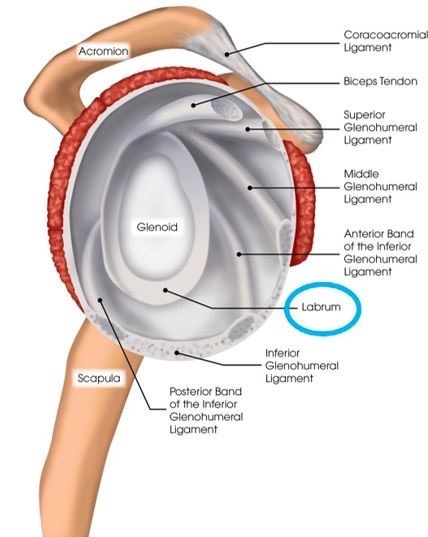Following up on my last post about the subscapularis muscle, I'm diving deeper into another part of the shoulder that's crucial for throwers: the labrum. Specifically, I want to talk about undersurface labral tears—a sneaky injury that can completely derail a pitcher's season if it goes unnoticed.
The Labral Landscape: It's Not Just SLAP Tears
When most people think about labral tears, they immediately jump to SLAP tears. But there's a whole world of labral pathology out there: Bankart tears, posterior labrum tears, and the ones I really want to focus on today—undersurface tears.
Here's the thing about baseball pitchers: every time they throw, they're putting massive distraction forces through their shoulder. The humeral head is literally being pulled away from the socket, and it's the labrum—especially the superior and posterior parts—that has to resist all that tension. When that system breaks down, you get tears that can develop so gradually the pitcher doesn't even realize what's happening.
Understanding the Labrum's Role
The labrum acts as both a stabilizer and shock absorber, deepening the shallow glenoid socket and providing attachment points for ligaments and the biceps tendon. In throwers, it's under constant stress from the extreme forces of pitching.
Why These Tears Are So Hard to Catch
I've seen this countless times: a pitcher comes in complaining of vague shoulder discomfort, nothing too dramatic. Maybe it's just a dull ache in the back of their shoulder, or they feel like something's "not quite right" when they throw.
The problem? Undersurface labral tears are masters of disguise. They don't always cause sharp pain or obvious instability like SLAP and Bankart tears. Instead, they can mimic internal impingement, rotator cuff irritation, or even just general shoulder fatigue. This is why imaging and advanced diagnostics are so important when dealing with throwers who have ambiguous posterior shoulder pain.
Obvious Labral Tears
- • Sharp, catching pain
- • Clear instability episodes
- • Positive provocative tests
- • Obvious on imaging
Undersurface Tears
- • Vague posterior discomfort
- • Subtle instability feelings
- • Negative standard tests
- • Requires advanced imaging
Diagnosis: What Actually Works
Traditional MRI arthrograms are still your best bet, with about 80–85% accuracy. But I've been following some research on deep learning models that can identify these subtle patterns even on standard MRIs—no contrast needed. This could be a game-changer for early detection.
For physical exams, no single test gives you a definitive answer. I like using what researchers call the "3-Pack": O'Brien's active compression test, resisted throwing position, and bicipital palpation. When you combine these with the uppercut test, your accuracy goes way up.
The Mechanics Behind the Injury
During the late cocking phase of pitching, the humeral head experiences distraction forces that can exceed 1,000 Newtons. The posterior-superior labrum bears the brunt of this load. Over thousands of throws, this creates a "peel-back" mechanism where the biceps-labral complex gets subjected to torsional and tensile forces simultaneously.
If a pitcher has GIRD (glenohumeral internal rotation deficit) or scapular dyskinesis, they're setting themselves up for trouble. These conditions change normal mechanics and put even more stress on an already vulnerable structure.
I know this firsthand—during my playing career, I developed a labral tear from bony growth that formed on my humeral head. The constant throwing motion had created bone spurs that eventually tore my labrum, ending my collegiate baseball career. It's a harsh reminder of how these seemingly small mechanical issues can snowball into career-ending injuries if left unchecked.
What is GIRD?
GIRD (Glenohumeral Internal Rotation Deficit) occurs when a pitcher loses internal rotation range of motion in their throwing shoulder compared to their non-throwing side. This typically happens from posterior capsule tightness and is common in overhead athletes. When you can't internally rotate normally, your body compensates in ways that put extra stress on the labrum and other shoulder structures.
⚠️ The Perfect Storm
When GIRD, scapular dyskinesis, and high throwing volumes combine, the risk for undersurface labral tears increases dramatically. Early recognition of these risk factors is crucial for prevention.
My Treatment Philosophy: Rehab First, Surgery as a Last Resort
I'm a big believer in trying conservative treatment first, especially for undersurface tears. A focused rehab plan that hits posterior capsule stretching, scapular control, and smart strengthening usually works better than jumping straight to surgery.
My Treatment Approach:
1. Activity Modification: Temporary reduction in throwing to allow tissue healing
2. Address GIRD: Posterior capsule stretching to restore normal internal rotation
3. Scapular Control: Restore proper movement patterns and reduce compensations
4. Progressive Loading: Gradual strengthening and return-to-throwing program
When surgery becomes necessary, precision is key. SLAP repairs have inconsistent return-to-play success in throwers, so biceps tenodesis is increasingly used. The goal is restoring stability without compromising the range of motion essential for throwing.
⚠️ Surgical Reality Check
Return-to-sport rates after labral repair in throwers vary widely (40-90%), with better outcomes in younger athletes with isolated tears and good preoperative function.
What I Want You to Remember
Don't dismiss vague posterior shoulder pain. If a thrower says something doesn't feel right, keep undersurface labral tears on your radar.
Use test clusters, not single tests. Combine O'Brien's, uppercut test, and palpation to increase diagnostic confidence.
Give rehab a real shot. Focusing on biomechanics first often gets better results than surgery.
Screen early and often. Regular checks for GIRD, scapular dyskinesis, and posterior capsule tightness can prevent problems.
The Bottom Line
Look, I've been on both sides of this—as a player who ignored the warning signs and as a coach who's learned to spot them early. These undersurface tears are sneaky, but they leave clues if you know what to look for. Don't let vague shoulder pain turn into something that sidelines you for months. Trust your gut, get it checked out, and give conservative treatment a real shot before jumping to surgery.

